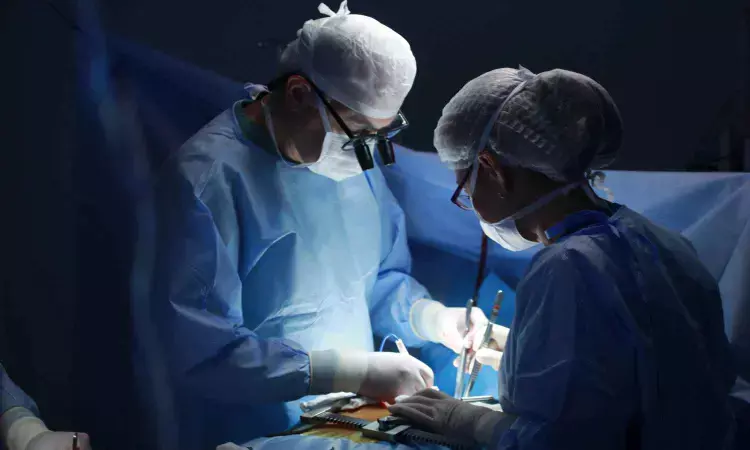- Home
- Medical news & Guidelines
- Anesthesiology
- Cardiology and CTVS
- Critical Care
- Dentistry
- Dermatology
- Diabetes and Endocrinology
- ENT
- Gastroenterology
- Medicine
- Nephrology
- Neurology
- Obstretics-Gynaecology
- Oncology
- Ophthalmology
- Orthopaedics
- Pediatrics-Neonatology
- Psychiatry
- Pulmonology
- Radiology
- Surgery
- Urology
- Laboratory Medicine
- Diet
- Nursing
- Paramedical
- Physiotherapy
- Health news
- Fact Check
- Bone Health Fact Check
- Brain Health Fact Check
- Cancer Related Fact Check
- Child Care Fact Check
- Dental and oral health fact check
- Diabetes and metabolic health fact check
- Diet and Nutrition Fact Check
- Eye and ENT Care Fact Check
- Fitness fact check
- Gut health fact check
- Heart health fact check
- Kidney health fact check
- Medical education fact check
- Men's health fact check
- Respiratory fact check
- Skin and hair care fact check
- Vaccine and Immunization fact check
- Women's health fact check
- AYUSH
- State News
- Andaman and Nicobar Islands
- Andhra Pradesh
- Arunachal Pradesh
- Assam
- Bihar
- Chandigarh
- Chattisgarh
- Dadra and Nagar Haveli
- Daman and Diu
- Delhi
- Goa
- Gujarat
- Haryana
- Himachal Pradesh
- Jammu & Kashmir
- Jharkhand
- Karnataka
- Kerala
- Ladakh
- Lakshadweep
- Madhya Pradesh
- Maharashtra
- Manipur
- Meghalaya
- Mizoram
- Nagaland
- Odisha
- Puducherry
- Punjab
- Rajasthan
- Sikkim
- Tamil Nadu
- Telangana
- Tripura
- Uttar Pradesh
- Uttrakhand
- West Bengal
- Medical Education
- Industry
What are Risk Factors for conversion of minimally invasive gynaecologic oncology surgeries to Laparotomy?

Gynaecologic malignancies contribute significantly to morbidity and mortality with more than half of the cost is associated with hospital stays for diagnosis and treatment. Recent study aimed to identify novel risk factors for conversion from minimally invasive to open surgeries for gynecologic oncology operations. The researchers conducted a retrospective cohort study of 1,356 patients who underwent surgeries for gynecologic masses or malignancies between 2015-2020 at a single academic medical center. The key findings of the study were: 1. Overall conversion rate from minimally invasive to open surgery was 6.1% (43/704 cases). 2. Patients who required conversion had significantly lower preoperative hemoglobin levels compared to minimally invasive and open surgery cases (11.6 ± 1.9 vs 12.8 ± 1.5 vs 11.8 ± 1.9 g/dL, p<.001). 3. Patients with preoperative hemoglobin <10 g/dL had an adjusted odds ratio of 3.94 for conversion, while patients with BMI ≥30 kg/m2 had an adjusted odds ratio of 2.86 for conversion. 4. A risk prediction model incorporating age >50 years, BMI ≥30 kg/m2, ASA status >2, and preoperative hemoglobin <10 g/dL had an AUROC of 0.71, indicating good discriminatory ability. Patients with 2 or more risk factors had a 12% conversion rate.
Novel Findings
The novel finding of lower preoperative hemoglobin as a significant risk factor for conversion provides important insights. Lower hemoglobin may signal greater disease burden and extent of adhesions, leading to increased conversion risk. Incorporating this variable into a risk prediction model can help surgical teams better anticipate conversion, allowing for improved preoperative planning and patient counseling. This can ultimately improve outcomes for patients undergoing minimally invasive gynecologic oncology procedures.
Key Points
Here are the 6 key points from the research paper: 1. The overall conversion rate from minimally invasive to open surgery was 6.1% (43/704 cases). 2. Patients who required conversion had significantly lower preoperative hemoglobin levels compared to minimally invasive and open surgery cases (11.6 ± 1.9 vs 12.8 ± 1.5 vs 11.8 ± 1.9 g/dL, p<.001). 3. Patients with preoperative hemoglobin <10 g/dL had an adjusted odds ratio of 3.94 for conversion, while patients with BMI ≥30 kg/m2 had an adjusted odds ratio of 2.86 for conversion. 4. A risk prediction model incorporating age >50 years, BMI ≥30 kg/m2, ASA status >2, and preoperative hemoglobin <10 g/dL had an AUROC of 0.71, indicating good discriminatory ability. Patients with 2 or more risk factors had a 12% conversion rate. 5. The novel finding of lower preoperative hemoglobin as a significant risk factor for conversion provides important insights, as lower hemoglobin may signal greater disease burden and extent of adhesions, leading to increased conversion risk. 6. Incorporating the preoperative hemoglobin variable into a risk prediction model can help surgical teams better anticipate conversion, allowing for improved preoperative planning and patient counseling, ultimately improving outcomes for patients undergoing minimally invasive gynecologic oncology procedures.
Reference –
Kevin H. Nguyen, Hyundeok Joo, Solmaz Manuel, Lee-may Chen & Lee- lynn Chen (2024) Incorporating low haemoglobin into a risk prediction model for conversion in minimally invasive gynaecologic oncology surgeries, Journal of Obstetrics and Gynaecology, 44:1, 2349960, DOI: 10.1080/01443615.2024.2349960
MBBS, MD (Anaesthesiology), FNB (Cardiac Anaesthesiology)
Dr Monish Raut is a practicing Cardiac Anesthesiologist. He completed his MBBS at Government Medical College, Nagpur, and pursued his MD in Anesthesiology at BJ Medical College, Pune. Further specializing in Cardiac Anesthesiology, Dr Raut earned his FNB in Cardiac Anesthesiology from Sir Ganga Ram Hospital, Delhi.
Dr Kamal Kant Kohli-MBBS, DTCD- a chest specialist with more than 30 years of practice and a flair for writing clinical articles, Dr Kamal Kant Kohli joined Medical Dialogues as a Chief Editor of Medical News. Besides writing articles, as an editor, he proofreads and verifies all the medical content published on Medical Dialogues including those coming from journals, studies,medical conferences,guidelines etc. Email: drkohli@medicaldialogues.in. Contact no. 011-43720751


